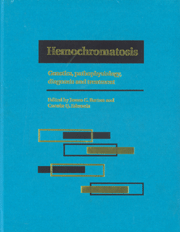Book contents
- Frontmatter
- Contents
- List of contributors
- Foreword
- Part I Introduction to hemochromatosis
- Part II Genetics of hemochromatosis
- Part III Metal absorption and metabolism in hemochromatosis
- Part IV Diagnostic techniques for iron overload
- Part V Complications of iron overload
- Part VI Therapy of hemochromatosis and iron overload
- Part VII Infections and immunity in hemochromatosis
- Part VIII Hemochromatosis heterozygotes
- Part IX Relationship of hemochromatosis to other disorders
- 42 Thalassemias and their interactions with hemochromatosis
- 43 Iron overload in sideroblastic and other nonthalassemic anemias
- 44 Hemochromatosis, iron overload, and porphyria cutanea tarda
- 45 Interactions of alcohol, iron and hemochromatosis
- 46 Iron overload in African Americans
- Part X Animal models of hemochromatosis and iron overload
- Part XI Screening for hemochromatosis
- Part XII Hemochromatosis: societal and ethical issues
- Part XIII Final issues
- Index
44 - Hemochromatosis, iron overload, and porphyria cutanea tarda
from Part IX - Relationship of hemochromatosis to other disorders
Published online by Cambridge University Press: 05 August 2011
- Frontmatter
- Contents
- List of contributors
- Foreword
- Part I Introduction to hemochromatosis
- Part II Genetics of hemochromatosis
- Part III Metal absorption and metabolism in hemochromatosis
- Part IV Diagnostic techniques for iron overload
- Part V Complications of iron overload
- Part VI Therapy of hemochromatosis and iron overload
- Part VII Infections and immunity in hemochromatosis
- Part VIII Hemochromatosis heterozygotes
- Part IX Relationship of hemochromatosis to other disorders
- 42 Thalassemias and their interactions with hemochromatosis
- 43 Iron overload in sideroblastic and other nonthalassemic anemias
- 44 Hemochromatosis, iron overload, and porphyria cutanea tarda
- 45 Interactions of alcohol, iron and hemochromatosis
- 46 Iron overload in African Americans
- Part X Animal models of hemochromatosis and iron overload
- Part XI Screening for hemochromatosis
- Part XII Hemochromatosis: societal and ethical issues
- Part XIII Final issues
- Index
Summary
Introduction
The term porphyria, derived from the Greek word porphyra, meaning purple, is apt because a hallmark of most of the porphyrias is the overexcretion of porphyrins in urine or feces. The porphyrins have a dark-red color that borders on purple. In most porphyrias, there are enzyme defects in the pathway of normal heme biosynthesis that cause the accumulation of porphyrins and porphyrin precursors. A summary of the pathway of heme biosynthesis showing the primary enzymatic defects in the porphyrias is displayed in Fig. 44.1. A classification of the porphyrias, emphasizing that either the liver or the bone marrow is the major site of overproduction of porphyrins and porphyrin precursors in these diseases, is shown in Table 44.1.
The major clinical features of the porphyrias are dermatologic and/or neurologic abnormalities. The types of porphyria in which dermatologic features predominate include porphyria cutanea tarda (PCT), the most common form of porphyria encountered world-wide. Hepatoerythropoietic porphyria is due to a rare, hereditary, severe deficiency in activity of the enzyme uroporphyrinogen decarboxylase (Uro-D), the enzyme that is also decreased in activity in PCT (Fig. 44.1). The severe deficiency in hepato-erythropoietic porphyria is due to homozygosity or compound heterozygosity for deficiency of Uro-D activity. Congenital erythropoietic porphyria (Günther's disease), also rare, is a form of usually severe cutaneous porphyria due to homozygous or compound heterozygous deficiency of the enzyme in the heme biosynthetic pathway immediately preceding Uro-D, namely, uroporphyrinogen III synthase (cosynthase).
- Type
- Chapter
- Information
- HemochromatosisGenetics, Pathophysiology, Diagnosis and Treatment, pp. 453 - 467Publisher: Cambridge University PressPrint publication year: 2000
- 7
- Cited by



